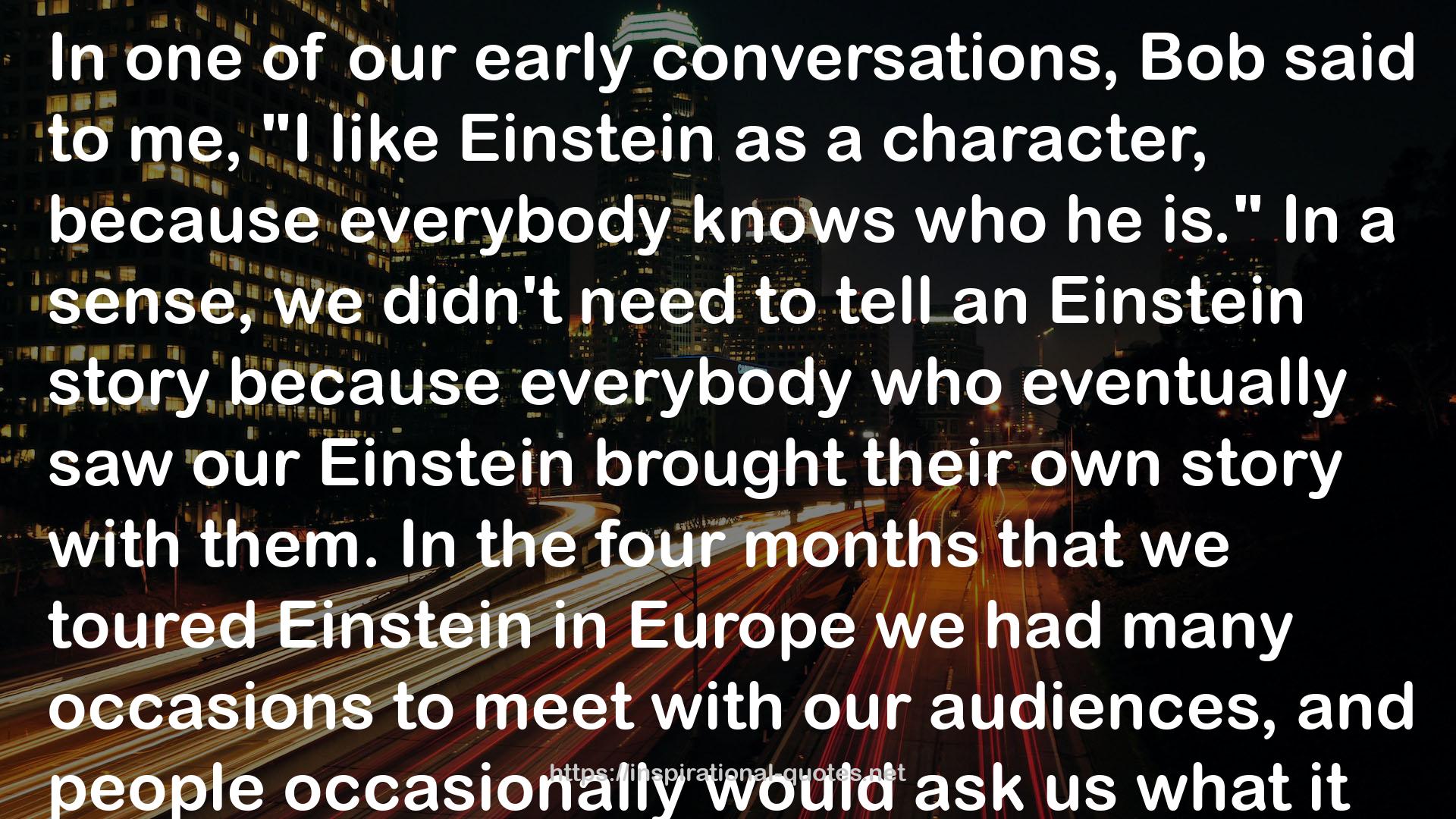" In one of our early conversations, Bob said to me, "I like Einstein as a character, because everybody knows who he is." In a sense, we didn't need to tell an Einstein story because everybody who eventually saw our Einstein brought their own story with them. In the four months that we toured Einstein in Europe we had many occasions to meet with our audiences, and people occasionally would ask us what it "meant." But far more often people told us what it meant to them, sometimes even giving us plot elucidation and complete scenario. The point about Einstein was clearly not what it "meant" but that it was meaningful as generally experienced by the people who saw it.
From the viewpoint of the creators, of course, that is exactly the way it was constructed to work. Though we made no attempt at all to tell a story, we did use dramaturgical devices to create a clearly paced overall dramatic shape. For instance, a "finale" is a dramaturgical device; an "epilogue" is another. Using contrasting sections, like a slow trial scene followed by a fast dance scene, is a dramaturgical device, and we used such devices freely. I am sure that the absence of direct connotative "meaning" made it all the easier for the spectator to personalize the experience by supplying his own special "meaning" out of his own experience, while the work itself remained resolutely abstract.
As to the use of three visual schemes, or images, Bob often mentioned that he envisioned them in three distinct ways: (1) a landscape seen at a distance (the Field/Spaceship scenes); (2) still lifes seen at a middle distance (the Trial scenes); and (3) portraits seen as in a closeup (the Knee Plays). As these three perspectives rotated through the four acts of the work, they created the sequence of images in an ordered scale.
Furthermore, the recurrence of the images implied a kind of quasi-development. For example, the sequence of Train scenes from the Act I, scene 1 Train, to the "night train" of Act II and finally the building which resembled in perspective the departing night train, presented that sequence of images in a reductive order (each one became less "train-like") and at the same time more focused and energized. The same process applies to the sequence of Trial scenes (ending with a bar of light representing the bed) as well as the Field/Spaceship, with the final scene in the interior of the spaceship serving as a kind of apocalyptic grand finale of the whole work. Each time an image reappeared, it was altered to become more abstract and, oddly enough, more powerful. The way these three sequences were intercut with each other, as well as with the portrait-scale Knee Plays, served to heighten the dramatic effect. "
Image for Quotes
 From the viewpoint of the creators, of course, that is exactly the way it was constructed to work. Though we made no attempt at all to tell a story, we did use dramaturgical devices to create a clearly paced overall dramatic shape. For instance, a "finale" is a dramaturgical device; an "epilogue" is another. Using contrasting sections, like a slow trial scene followed by a fast dance scene, is a dramaturgical device, and we used such devices freely. I am sure that the absence of direct connotative "meaning" made it all the easier for the spectator to personalize the experience by supplying his own special "meaning" out of his own experience, while the work itself remained resolutely abstract.
From the viewpoint of the creators, of course, that is exactly the way it was constructed to work. Though we made no attempt at all to tell a story, we did use dramaturgical devices to create a clearly paced overall dramatic shape. For instance, a "finale" is a dramaturgical device; an "epilogue" is another. Using contrasting sections, like a slow trial scene followed by a fast dance scene, is a dramaturgical device, and we used such devices freely. I am sure that the absence of direct connotative "meaning" made it all the easier for the spectator to personalize the experience by supplying his own special "meaning" out of his own experience, while the work itself remained resolutely abstract.As to the use of three visual schemes, or images, Bob often mentioned that he envisioned them in three distinct ways: (1) a landscape seen at a distance (the Field/Spaceship scenes); (2) still lifes seen at a middle distance (the Trial scenes); and (3) portraits seen as in a closeup (the Knee Plays). As these three perspectives rotated through the four acts of the work, they created the sequence of images in an ordered scale.
Furthermore, the recurrence of the images implied a kind of quasi-development. For example, the sequence of Train scenes from the Act I, scene 1 Train, to the "night train" of Act II and finally the building which resembled in perspective the departing night train, presented that sequence of images in a reductive order (each one became less "train-like") and at the same time more focused and energized. The same process applies to the sequence of Trial scenes (ending with a bar of light representing the bed) as well as the Field/Spaceship, with the final scene in the interior of the spaceship serving as a kind of apocalyptic grand finale of the whole work. Each time an image reappeared, it was altered to become more abstract and, oddly enough, more powerful. The way these three sequences were intercut with each other, as well as with the portrait-scale Knee Plays, served to heighten the dramatic effect." style="width:100%;margin:20px 0;"/>